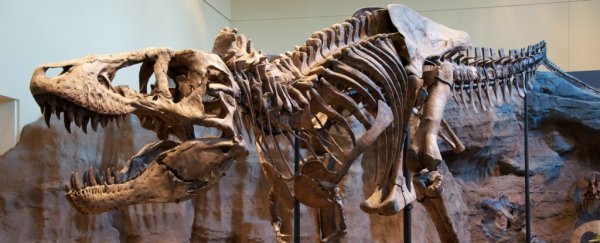It's 65 million years ago. You're taking a relaxing stroll through the forest, when in the distance, you hear thunderous stomping.
You've seen enough Jurassic Park movies to know it's time to run, but the stomping is still getting louder and louder.
As you sprint frantically through the forest, you turn to look over your shoulder. A T. Rex emerges from the trees and lets out a ferocious … coo.
At least, that's what a new study that will be published next month in the journal Evolution found. According to the study, large-bodied dinosaurs, like the T. Rex, did not communicate in roars, but in slightly less intimidating coos and mumbles.
The researchers came to these results by examining the closest things to a living dinosaur we've got: archosaurs (birds and crocodiles).
They examined the origin and the evolution of the archosaur vocal organ and the enormous repertoire of sounds that it can produce. Then, they compared this to vocal data collected about dinosaurs.
They found that birds have a special way of emitting sound, called closed-mouth vocalisation. This sound is produced through the skin in a bird's neck while its beak is closed.
"Looking at the distribution of closed-mouth vocalisation in birds that are alive today could tell us how dinosaurs vocalised," Chad Eliason, the study's co-author, said in a press release.
What was interesting was that only animals with a larger body size (the size of a dove or larger) used this closed-mouth vocalisation. Tobias Riede, the lead author of the study, said the association with large bodies has to do with physics.
"The inflation of an elastic cavity could present a size-dependent challenge," Riede said in the press release. "The lung pressure required to inflate a cavity depends on the tension in the wall of the cavity, and this tension increases for smaller body sizes."
These closed-mouth vocalisations, the researchers found, emerged in "diverse archosaur species depending on behavioural or environmental circumstances".
Although it's hard to reconstruct the sounds of the long-extinct dinosaurs (their fleshy vocal organs don't fossilise the way their bones do), the researchers had a few other hints to suggest that dinosaurs produced this type of sound.
Based on what scientists know about birds, dinosaurs likely did not have vocal cords, those "tough membranes that vibrate when a lion roars or a human speaks," the Washington Post reports. Instead, they had air sacs, and possibly even a birdlike syrinx, too.
"To make any kind of sense of what non-avian dinosaurs sounded like, we need to understand how living birds vocalise," Julia Clarke, co-author of the study, said in the press release. "This makes for a very different Jurassic world. Not only were dinosaurs feathered, but they may have had bulging necks and made booming, closed-mouth sounds."
This article was originally published by Business Insider.
More from Business Insider:
